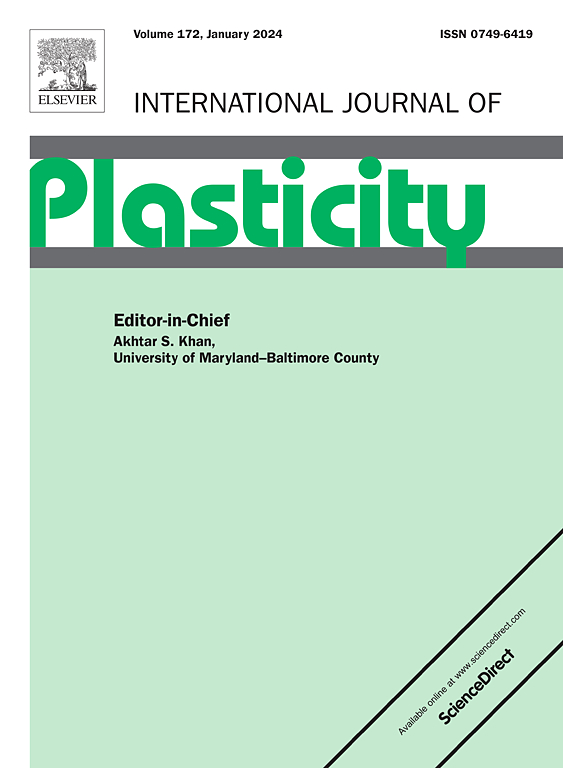增强应变梯度晶体塑性理论:变形过程中长度尺度的演化
IF 12.8
1区 材料科学
Q1 ENGINEERING, MECHANICAL
引用次数: 0
摘要
基于Nye张量的二次能量贡献,提出了一种增强应变梯度晶体塑性(Enhanced- sgcp)理论,该理论在热力学一致的框架内准确地捕获了微观结构中滑移和扭结带的剪切带形成。理论中的高阶模量与加载过程中不断变化的微观结构特性有着内在的联系,引入了一个控制剪切带形成和演化的物理长度尺度。结果表明,classic - sgcp模型(一种gurtin型非局域理论)导致局域带宽度增加,最终消失,导致微观结构内均匀变形。这种效应是由几何上必要的位错的过度湮灭引起的,它抑制了局部化,并可能导致剪切带形成中物理上无意义的结果。为了解决这一问题,本文提出的Enhanced-SGCP理论通过降低与硬化缺陷清除和局部软化机制相关的高阶模量,有效地保留了剪切带宽度,并在整个加载过程中保持了局部化。此外,该理论建立了扭结带中的晶格曲率与奈张量之间的直接联系,证明了扭结带转化为滑移带。因此,Enhanced-SGCP理论打破了滑移带和扭结带之间的等效性,为辐照材料的应变局部化机制提供了更准确的物理表征。为了计算求解控制平衡方程,提出了一种基于快速傅立叶变换(FFT)的不动点算法。为了验证该算法的有效性,给出了增强型sgcp理论的解析解。高分辨率单晶模拟证实,在提出的Enhanced-SGCP框架内,扭结带通过不同的物理长度尺度转变为正则化的滑移带。此外,考虑不同长度尺度和晶界高阶界面条件,对二维和三维多晶聚集体进行了高分辨率模拟。结果表明,加载过程中的应变梯度效应被增强的sgcp理论饱和和稳定,确保了持续的局部化。这些发现突出了所提出的Enhanced-SGCP理论和开发的fft算法的能力,为晶体材料的应变局部化建模提供了一个强大的、物理上一致的框架。所提出的模型对经典方法进行了重大改进,特别是在保留局部化现象和准确描述滑移带和扭结带之间的相互作用方面。本文章由计算机程序翻译,如有差异,请以英文原文为准。
Enhanced Strain Gradient Crystal Plasticity theory: Evolution of the length scale during deformation
An Enhanced Strain Gradient Crystal Plasticity (Enhanced-SGCP) theory, based on the quadratic energy contribution of the Nye tensor, is developed within a thermodynamically consistent framework to accurately capture shear band formation in terms of slip and kink bands within the microstructure. The higher-order modulus in the theory is intrinsically linked to the evolving microstructural properties during applied loading, introducing a physical length scale that governs shear band formation and evolution. It is demonstrated that the Classical-SGCP model (a Gurtin-type nonlocal theory) leads to an increasing width of localization bands, which eventually disappear, resulting in homogeneous deformation within the microstructure. This effect arises from the excessive annihilation of geometrically necessary dislocations, which suppresses localization and may lead to physically meaningless results in the formation of shear bands. To address this issue, the proposed Enhanced-SGCP theory effectively preserves the shear band width and maintains localization throughout the loading process by reducing the higher-order modulus associated with the sweeping away of hardening defects and local softening mechanism. Furthermore, the theory establishes a direct link between lattice curvature in kink bands and the Nye tensor, demonstrating that the kink bands transform into slip bands. Consequently, the Enhanced-SGCP theory breaks the equivalence between slip and kink bands, providing a more accurate physical representation of strain localization mechanisms in irradiated materials.
To computationally solve the governing balance equations, a fixed-point algorithm based on the fast Fourier Transform (FFT) method is developed. To validate the algorithm, an analytical solution for the Enhanced-SGCP theory is derived. High-resolution single-crystal simulations confirm that the kink bands transition into regularized slip bands through different physical length scales within the proposed Enhanced-SGCP framework. Furthermore, high-resolution simulations are performed on two-dimensional and three-dimensional polycrystalline aggregates, considering different length scales and various higher-order interface conditions at the grain boundaries. The results reveal that the strain gradient effects during applied loading are saturated and stabilized by the Enhanced-SGCP theory, ensuring sustained localization.
These findings highlight the capability of the proposed Enhanced-SGCP theory and the developed FFT-algorithm to provide a robust and physically consistent framework for modeling strain localization in crystalline materials. The proposed model offers significant improvements over classical approaches, particularly in preserving localization phenomena and accurately describing the interplay between slip and kink bands.
求助全文
通过发布文献求助,成功后即可免费获取论文全文。
去求助
来源期刊

International Journal of Plasticity
工程技术-材料科学:综合
CiteScore
15.30
自引率
26.50%
发文量
256
审稿时长
46 days
期刊介绍:
International Journal of Plasticity aims to present original research encompassing all facets of plastic deformation, damage, and fracture behavior in both isotropic and anisotropic solids. This includes exploring the thermodynamics of plasticity and fracture, continuum theory, and macroscopic as well as microscopic phenomena.
Topics of interest span the plastic behavior of single crystals and polycrystalline metals, ceramics, rocks, soils, composites, nanocrystalline and microelectronics materials, shape memory alloys, ferroelectric ceramics, thin films, and polymers. Additionally, the journal covers plasticity aspects of failure and fracture mechanics. Contributions involving significant experimental, numerical, or theoretical advancements that enhance the understanding of the plastic behavior of solids are particularly valued. Papers addressing the modeling of finite nonlinear elastic deformation, bearing similarities to the modeling of plastic deformation, are also welcomed.
 求助内容:
求助内容: 应助结果提醒方式:
应助结果提醒方式:


